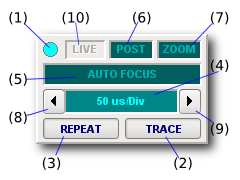
It provides the TIMEBASE (4), ZOOM (7) and FOCUS (5) parameters.

TIMEBASE and ZOOM combined set the time scale in seconds per division at which to display the waveform. FOCUS chooses which part of the waveform (specified as a time offset relative to the trigger) to display.
All channels use the same timebase parameters so they remain time synchronised. FOCUS may be arbitrarily set subject to available pre-trigger buffers and post- trigger delays supported by the connected BitScope.
The timebase control also provides the TRACE (2) and REPEAT (3) capture controls and other parameters which manage buffers (6) and display refresh (3).
All timebase parameters and widgets respond to Act On Gestures as listed here:
| ID | WIDGET | DESCRIPTION |
| (1) | LED | Highlights to indicate activity. |
| (2) | TRACE | Start and Stop waveform capture and display (Click). |
| (3) | REPEAT | Selects one-shot or repeat capture and sets frame rates (Click, Choose) |
| (4) | TIMEBASE | Set or adjust the time scale in S/Div (Select, Choose, Change X) |
| (5) | FOCUS | Set (or track) the focus time (Click, Choose, Select, More, Less, Change X) |
| (6) | BUFFER | Selects how much buffer to use pre and post trigger (Click, Choose) |
| (7) | ZOOM | Adjust time scale post capture (Select, Choose, More, Less, Change X) |
| (8) | SLOWER | Make the timebase slower in 1, 2, 5 steps (Click) |
| (9) | FASTER | Make the timebase faster in 1, 2, 5 steps (Click) |
| (10) | SOURCE | Selects between live waveforms, presets and recorded waveform data. |
The SOURCE parameter is not (yet) active as of the current version but some of its functions are available via the built-in DSO Data Recorder.
TRACE and REPEAT control waveform capture and replay for all virtual instruments.

Clicking TRACE initiates a single (i.e. one-shot) waveform capture on all enabled channels and displays the result. Clicking REPEAT does the same thing but capture continues indefinitely, updating the display in real-time until stopped. Choosing the REPEAT button pops up a frame rate menu to adjust the capture rate.
Is it important to understand that TRACE and REPEAT on their own are not enough to guarantee capture proceeds; the trigger condition must be satisfied or auto trigger must be enabled.
By default, repeat trace, auto trigger and CH-A are all enabled which ensures something appears on the display as soon as DSO starts. However when doing one-shot capture or when looking at intermittent signals it may be better to turn off auto trigger after a trigger condition as been set.
Waveform capture can be terminated by Clicking up the REPEAT or TRACE button.
However there is an important difference between these two options:
In general Clicking up REPEAT is the recommended way to terminate repeating capture.
It is also important to understand that as soon as TRACE or REPEAT is clicked to commence a new capture, any waveform previously displayed will be overwritten immediately. If you don't want to lose previously captured waveforms the data recorder can be enabled prior to capture.
The reason waveforms are overwritten (unless the recorder enabled) is that as soon as a new trace is commenced the capture buffer is filled with new data even if no trigger is seen i.e. BitScope does not wait for a trigger to start capture. If it did, signals before the trigger could not be captured.
When replaying previously recorded waveforms (SOURCE is set to REPLAY) TRACE and REPEAT control the replay of the recorded waveforms instead of the capture of new waveforms.
The rate at which repeat capture display refresh occurs is called the frame rate.
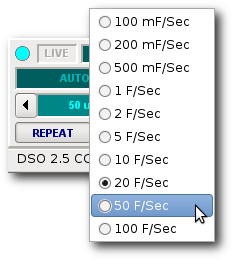
Choose the REPEAT button to pop up the menu to change the frame rate. Whether DSO can actually refresh at the requested rate depends on a number of factors:
When run on a computer with a 1GHz or greater speed CPU, even with modest graphics cards, the maximum display refresh rate can typically reach 50Hz or beyond.
Even low cost Netbooks are usually capable of this.
On older PCs or where the link speed is slow (eg, connected to a Network BitScope via a limited bandwidth Internet connection) or when run on a very high resolution displays, the frame rate may be lower (for example connecting to SYDNEY).
The TIMEBASE parameter sets the primary time per division at which to capture and display.

Click on the FASTER and SLOWER buttons on the left and right of the timebase parameter to change it in a 1, 2, 5 sequence. Choose the timebase parameter to pop-up a menu of values or Change X to adjust it arbitrarily and in real-time. Select the timebase to toggle between the two most recently used values and make comparisons between two different timebase values.
Timebase implicitly sets the capture sample rate; for a given timebase DSO always uses the highest sample rate it can based on the selected buffer size to maximize the non-interpolating timebase zoom range and capture waveforms with the highest possible resolution.
All BitScopes can capture far more data than is usually shown on the display at once.
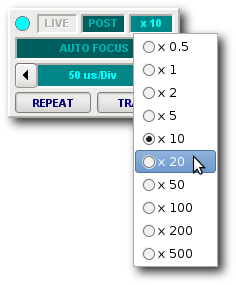
The timebase zoom takes advantage of this by allowing one to zoom in on fine waveform details or zoom out to see an overview of the entire waveform on the display.
Unlike the timebase, zoom operates on previously captured waveforms and is instantaneous. Its range depends on the available buffers (device dependent).
The zoom menu shown here is for BS325.
Use More, Less or Choose to increase, decrease or select a timebase zoom directly. Select to toggle between the two most recently used values.
The timebase and zoom parameters combined define the time scale used to display captured waveforms. This time scale is also reported in seconds per division but at the bottom of the display not on the timebase itself.

In this example x 10 timebase zoom results in a timebase of TB = 5uS/Div being reported on the display.
Whatever combination of timebase and zoom is used, the resulting time scale is always shown at the bottom of the display. If the graticule is disabled (ie. there are no divisions on the display) the time scale is reported as time per display instead of time per division.
The focus parameter specifies the time (relative to the trigger) at the middle of the display.

It is specified in seconds where positive values locate the display after the trigger and negative values before it. A value zero means the trigger is at the center of the display.
In this example the center of the display (and any waveform appearing there) is located precisely 984 ms and 37.02 us after the trigger point.
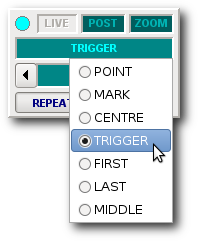
Use More and Less to increase or decrease the focus time by one display division, Choose to assign it directly, Change X to adjust it continously or Select to toggle Auto Focus mode.
Focus time may be automatically updated and/or assigned. Select the focus parameter to toggle auto focus on and off.
When enabled, AUTO FOCUS appears (instead of a numeric value) and the focus is automatically updated to ensure the trigger point is visible, either in the middle of the display (if pre-trigger is enabled) or at the left (if post-trigger only).
In addition to manual adjustment, there are seven other cue points which may be assigned to the focus.
| CUE POINT | DESCRIPTION |
| TRIGGER | Locate the focus to trigger point. If capture is post-trigger only, no waveform will appear on the left half of the display (because there is no data before the trigger) |
| FIRST | Locate the focus to the first sample in the capture buffer. If viewing one-shot capture, no waveform will appear on the left half of the display. If viewing a repeating capture the buffer will relocate to show waveform on the left too. |
| LAST | Locate the focus to the last sample in the capture buffer. If viewing one-shot capture, no waveform will appear on the right half of the display. If viewing a repeating capture the buffer will relocate to show waveform on the right too. |
| MIDDLE | Locate the focus to the sample in the middle of the capture buffer. If viewing one-shot capture, locating to the middle offers the same amount of capture waveform on either side of the display. |
| POINT | Locate the focus to the point cursor. This shows the point cursor in the middle of the display but it may result in no visible waveform when looking at a one-shot capture (it depends what the focus was when it was captured). |
| MARK | Locate the focus to the mark cursor. This shows the mark cursor in the middle of the display but it may result in no visible waveform when looking at a one-shot capture (it depends what the focus was when it was captured). |
| CENTER | Locate the focus to the midpoint between and point and mark cursors. This aligns the display such that the cursors are located equidistant from the center of the display and may result in no visible waveform when looking at one-shot capture (it depends what the focus was when it was captured). |
When a cue point is assigned to the focus, the widget reports the cue name (not the numeric value of the time at that cue point). Click the focus to see what the numeric value is (if necessary).
The focus time parameter effectively scrolls waveforms on the display. It does this by combining two time related functions, waveform offset and post-trigger delay.
DSO automatically assigns the offset and (depending on its value) any post-trigger delay to ensure that waveforms that should appear on the display will appear upon completion of the next trace.
No complicated delay timebase setup or waveform offset calculations are required.
When viewing a one-shot capture, the duration of the buffered waveform is finite and it is possible to locate the focus such that no waveform will appear on the display (i.e. because the display has been located beyond an edge of the buffer). The buffer navigator on the display shows when this occurs and cue points can always be used to locate the display to available waveform data.
When viewing repeating capture, DSO continuously adjusts the waveform offset and post-trigger delay to ensure that waveform appears on the display at the specified time. This means one can update the focus and waveform will always be displayed at and around the focus point.
The focus can be changed without (practical) limit in the post-trigger (positive) direction because the post-trigger delay can become very large but there is a hard limit in the pre-trigger (negative) direction which is limited by the available capture buffer in the BitScope itself.
Tip: when using More, Less and Change X to adjust the focus time manually, the rate of change depends on the selected timebase. To make large changes (e.g. in seconds) choose a very slow timebase first and use a faster timebase to make finer changes.
By default DSO captures analog waveforms and logic that occur after the trigger.
The pre-trigger buffer parameter reports POST to indicate this.
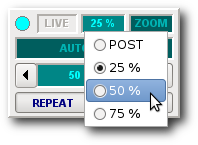
However full waveform and logic capture before the trigger is also possible. Choosing this parameter allows the selection of how much buffer to dedicate to pre-trigger waveform capture.
Important: this parameter provides guidance only as to how much buffer DSO should use for pre-trigger capture.
The actual amount used may be different and depends on the chosen focus time. If the focus time is set high enough such that the BitScope buffer is not large enough to capture before the trigger as well, it will reduce the pre-trigger buffer size.
Likewise if only 25% is requested but the focus time is set to sufficiently large negative value that waveform cannot be displayed without increasing the pre-trigger buffer it will be increased.
The only exception is post trigger only (i.e. POST). In this case no pre-trigger capture will be done regardless of the focus time (caveat emptor). If the BitScope used does not support pre-trigger it will also be disabled (applies to early BitScope models only). When pre-trigger capture is disabled for any reason, the parameter widget is "dimmed" it indicate this.